One of the most important things a backpacker can find is a great travel backpack. It holds all your gear, it’s with you almost all the time, and in some bizarre, anthropomorphic way, it’s your best friend. I still remember the feeling of coming back from my first solo backpacking trip, and walking around without a backpack. It felt wrong. Like something was missing.
Over the years, I’ve gone through packs like nobody’s business. I’ve never used the same pack for more than two trips, and no matter how many hours I spend either online or in the store, it seems like finding the right pack is always going to be a horrific ordeal.
Discomfort, poorly designed features, dangly straps, sizing issues, and all manner of nonsense have thwarted my path at every turn. It’s tough finding something that fits you properly, and I think, given the high user ratings of certain packs I hate, maybe I just have a bizarrely crooked spine and it’s not their fault.
But I refuse to let them get away with rant-free ease.
“Travel” packs barely exist
Part of the problem is that, up until very recently, the only options were top-loading hiking backpacks, or wheeled suitcases. Other options like duffel bags or school backpacks exist as well, but these are rarely suitable for round-the-world travel.
But since these were the only options, accepting their flaws was all I could do. And besides, high-quality hiking backpacks will stand up to most abuse, and they’ll be super comfortable if they fit you properly. But they’re not ideally suited for travel. Hiking packs work, but we’ve only been using them because nothing else was better.
The problem(s) with hiking backpacks:
Now don’t get me wrong; hiking backpacks are great, and I’ve used them on plenty of trips. Some designs have none of these flaws; it’s just that they usually do:
- Packing inconvenience: Hiking packs are usually top-loading, cavernous cylinders that swallow your gear and you have to dig everything out to find whatever’s at the bottom. You can mitigate this problem with packing cubes, but suitcase-style openings are so easy to manufacture that it’s insulting how rarely they’re implemented.
- Extraneous strap dangle: Hiking packs have all sorts of compression straps and attachment points. These are useful for walking around, but they’ll get scratched up when you throw them in the luggage compartment for a bus ride. And I’m including shoulder and hip straps here, too. If you ever have to check your bags for a flight, they’ll come out a little more damaged every time.
- No locking mechanism: Top loaders usually use a drawstring opening, which offers no security whatsoever against unscrupulous hostel bunkmates. This problem can be mostly solved with a laptop sleeve that can lock itself to a bed, but lockable zippers would be easier (though I’ve softened this requirement, as zippers can be easily bypassed, even when locked).
And in many cases, plenty of hiking packs have dumb design errors anyway, even if you’re just hiking.
The problem(s) with so-called “travel backpacks:”
Several companies design what they call “travel backpacks,” which have better features, solving some of the problems listed above, but they generally screw things up in the meantime as well:
- Size: They’ll make them so gigantic that you have to check them on a plane. Some of these “travel backpacks” go up to 80 liters. I’ve done RTW travel with 20. The carry-on max of 45 liters is plenty! Who the hell needs 80?!?!
- De-hydration pockets: They’ll skip the damn water bottle side pockets and then where the hell do they go?!?!?
- Filthy dirty lie “panel” loading: They’ll forget to make the suitcase-style opening go all the way around, thus defeating the purpose of the panel in the first place.
Sigh.
Which is why I’m so gleefully pleased that certain companies have been designing travel backpacks. Correctly, I might add.
I don’t know why the other people didn’t bother doing it before.
What the best travel backpacks get right
I’ve compiled a list of some of the best travel backpacks for carry-on use I can find. These packs are made for travelers, not hikers. They’ve got panel-loading convenience, not top-loading caverns; they’ve got lockable zippers, not drawstring uselessness; they’ve got carry-on dimensions, and minimal, hide-away straps, not monstrous bulges and streamers hanging from every angle. They can be carry-ons, or they can be checked luggage, without getting ruined.
Oh, and they’re not ugly. To me, that counts. Who the hell ever thought fluorescent orange was sexy? The 80s? Yeah, stay there.
I’ve organized this list by type. Let’s begin:
Option 1: Full size and full-featured
These packs have everything you could want; maximized dimensions, panel access, a laptop compartment, and lots of internal and external organizational pockets. There’s nothing missing.
1) Tortuga Outbreaker Backpack
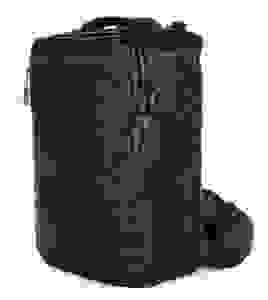
Tortuga was started by a random team of people who found themselves complaining about how they couldn’t find a travel pack that wasn’t awful. They’ve been outfitting nomads ever since.
Expected features on this pack include the full-length panel-loading design, to allow plenty of easy access to everything inside, and the dedicated laptop compartment opens fully flat, so you don’t need to remove your laptop at the security conveyor belt. The inside has even more pockets than the outside, and several compartments (the important ones) feature locking zippers. The “organizer panel” compartment is my favorite feature, with slots for pens, cards, and other small items, and the sheer number of pockets, both inside and out, will offer more organization than anything else you’re going to find.
Tortuga is currently on the third version of this pack, and the new design has a height-adjustable suspension system, meaning it will fit people of all sizes. It also has a seriously padded hip belt, which is rare for these packs, along with a seriously cushioned back panel (with raised ventilation) and shoulder straps. It’s the most heavy-duty suspension system of any travel pack out there, and although it’s significantly heavier as a result, it’s going to excel at carrying heavier loads. They’ve eliminated the ability to stow the shoulder straps and the suitcase handle, however, emphasizing its backpack features exclusively. The side grab handle is also gone, replaced with an extra mesh pocket.
It’s available in 35 and 45 liter capacities, to match the carry-on size requirements of European budget carriers, or North American airlines, respectively. I would say that because the pack features such a heavy-duty suspension system, it actually makes more sense in the 45 liter version. With a full load at that size, you’re definitely going to appreciate the extra cushioning, but at 35 liters, it might feel like overkill, especially since this is one of the heaviest packs out there.
Though Tortuga has released lighter packs, I much prefer the shoulder straps on this model, as they’re much more comfortable on me than either of the new ones they’ve released. If you’re looking for a 45 liter pack, this is as feature-rich as it gets, and definitely one of my top choices at that size.
You can get it from Tortuga. Their blog is also great, with all sorts of packing and travel tips.
Update: I received a test sample of the 35 liter version of this pack, and put it to the test! Check it a detailed review here.
2) Rick Steves Convertible Carry-on
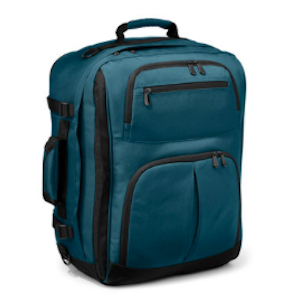
Long before anyone else got started in the carry-on travel backpack game, Rick Steves was galavanting around Europe with his own personal travel gear, designed exactly the way he liked it.
He gave it the features that later became standard on other packs, such as a fully opening panel that allows easy access to everything inside, along with hide-away backpack and waist straps, and suitcase-style grab handles. Exterior pockets are also quite generous, including a dedicated laptop compartment that became a later addition in an updated version.
But it has a few extra touches, such as a separate interior compartment for shoes or dirty clothes, and includes two mesh bags and a removable documents pouch, which you can remove and take with you instead of leaving it in a room. Lastly, the pack is sized to accommodate North American carry-on dimensions, but can expand with a compression zipper in case you stock up on too many souvenirs.
It’s easily the most affordable option on this list, although they do recommend using packing cubes inside to create more structure along the back panel. If you don’t, it can sag quite a bit, putting the weight on your shoulders instead of your hips. The compression straps on the side help with this quite a bit, so just make sure to pack it right, or it’ll feel heavier than it really is.
You can pick it up here.
3) Pacsafe Venturesafe EXP45

Pacsafe is known for its anti-theft approach in everything they do, and this pack is no exception. Not only does it have lockable zippers, but it has zippers that are resistant to the “pen trick,” which is a method thieves can use to break into a pack, even if it’s locked. It’s a huge nuisance that travelers need to know about, but it’s solved here, by placing a redundant set of teeth on the opposite side of each zipper, which prevents a pen from breaking through the chain. It also has slash-proof materials, to prevent hit-and-run theft.
Beyond that, it has a fully-opening suitcase-style main compartment, a laptop sleeve and organizational area in the front, and tuck-away straps. The carry-on dimensions, multiple grab handles, and compression straps make it portable, and versatile.
Pacsafe currently makes this version in a few different sizes, and they have other Venturesafe models available as well (such as the Vibe and X40), but I think this one has the best combination of features, especially in terms of organization. The others are lacking some extra compartments, for example, making this one the most recommendable of their selection. I wouldn’t say it has that much organization, but the organizer panel goes a long way toward keeping everything neat and tidy.
Get it here.
4) GoRuck G2
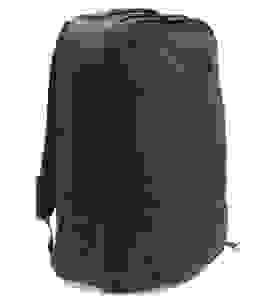
GoRuck has gained something of a reputation for designing some of the longest-lasting gear you can find, built for crazy endurance events and military use. They have packs of several different sizes (including multiple capacities, even if the packs have the same name), but the 40 liter G2 is the one I’m highlighting here.
The pack features a fully panel-loading design, a separate laptop compartment, and another exterior panel-loading compartment for extra organization. It also has those webbing loops all over the place for adding extra accessories or lashing gear to the outside, including a separately available padded hip belt, which I would call a necessity if you’re going for the 40 liter version. The sternum strap is also a separate accessory, so be sure to pick that up if you need it. You can tell it was originally designed for super tough, muscular guys, but it’s nice how they’ve accommodated scrawny weaklings with those extra touches.
As for the downside, the heavy-duty materials and construction make this pack heavy, and pricy…in fact it’s the heaviest and most expensive option listed here, but if you’re big enough to handle the heavier load and you want something that’ll pretty much last forever, the G2 is the one that’ll handle it.
The newly-developed G3, at 45 liters and with an integrated hip belt, nearly made the list here, but the slightly smaller G2 has that extra outside compartment for greater organization, so it just edges out the victory, at least in my opinion. Since the design doesn’t have much in the way of exterior organization, I think that’s an important feature. I do like the G3’s integrated hip belt, however, which is a more natural design element than the G2’s after-the-fact accessory hip belt add-on.
Pick it up here.
Option 2: Svelte and Slim
At 35 liters each, these are for lighter travelers who don’t need to max out on the size, but still want all the convenience of easy packing and laptop compatibility. They’ve got all the important features you’d want, in a slimmed-down size.
5) Minaal Carry-on Backpack
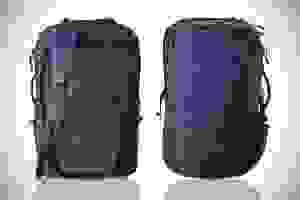
This one is yet another creation in the long, adorable line of things that were invented because people got sick and tired of endlessly having to deal with things that sucked.
This Kickstarter-backed project came about when two long-time travelers decided to make the pack they would have wanted. They set out to create the perfect travel pack for digital nomads, and its design (and Kickstarter success) just goes to show how rarely some of the major players stop to think about the needs of backpackers.
The Minaal has all of the major features you’d expect, including the fully-opening main panel, a separate laptop compartment, hide-away straps, locking zippers, multiple grab handles, and carry-on dimensions, even for the stricter European airlines. It has a few exterior pockets and internal dividers as well, along with a removable rain cover, and a removable, padded hip belt. It’s lighter and simpler than some of the larger packs, and it’s part of the reason I think this relatively minimal level of strap cushioning is kind of all you need at this size. The water bottle pocket is pretty tight, but there’s an elastic band in there that’ll hold taller bottles in place if necessary.
The pack is light, but also unstructured; packing cubes are definitely helpful here, especially since the main compartment tends to flop around quite a bit when you’re trying to pack it. The back panel isn’t too rigid either, so to keep it from sagging, using packing cubes and tightening the compression straps would be a good idea.
Get one here.
Update: This bag is now in version 2.0, and is even better than the original! They’ve sent me a test sample, and I’ve written about it in-depth here.
6) Cotopaxi Allpa 35
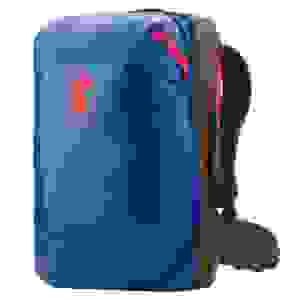
For those who love travel, but only in Punky Brewster colors. But don’t worry, it also comes in black.
This is a relatively new offering, but it does quite a few clever things that look great; it opens up like a suitcase, but splits the gear in half, rather than simply opening with a flap. It has a separate laptop and tablet sleeve, some exterior pocket access (including a way to access the main compartment without pulling open the main zipper), and a neat theft-prevention trick of leaving the zipper pulls on the opposite side of a webbing loop, where they’re hard to yank without fiddling with them a little.
The pack also has a number of optional accessories, such as an external mesh water bottle pocket, to add some customization. The extremely curvy shoulder straps (which tuck away when not in use) are also angled properly for smaller people with more angled shoulders, which I think is actually most people. It even throws in a rain cover, and the price is extremely competitive. I like the way it splits up the main compartment, giving you even more organization instead of using just one big space for everything, and also how it allows you to access those areas without opening up the main zipper. Plus it has those mesh doorways to keep everything in place, so you won’t make a mess even if you need to open up the main compartment. I suppose it could use a bit more mini-organization for pens and cards, but that’s about the only issue I can see.
The lower-right picture shows the pack with optional accessories, like the daypack and laundry bag, available separately.
Get it here.
7) Gregory Border 35
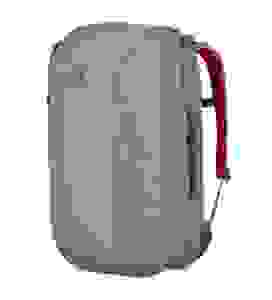
So Gregory is primarily a hiking pack company, and not as widely known as some of the bigger names in the industry, but whose packs I think are designed better than many of its competitors.
Their Border series consists of urban/travel backpacks, and this 35 liter version has not only a full-length panel-loading main compartment, but also a full-length panel loading laptop compartment; this means you just unzip and unfold this compartment, and lay it down on the airport security scanner, rather than removing the laptop at all. It’s quick and easy, and makes airport life just a little more convenient. The several exterior compartments allow for quick access, although there’s not a huge amount of organization here.
It’s missing a couple useful features, however. There’s no hip belt, no side water bottle pocket, and you can’t stow the straps away to use it as a suitcase (although it does have side carry handles). At 35 liters, you might not have to deal with checking the bag, but keep it in mind. Think of it as a budget version of the Minaal. The overall layout is similar, but it’s missing a few of the extra details. Without a hip belt, this’ll work better for larger people, or those who don’t plan on walking around too much with it, such as those who prefer taxis instead of hauling gear across town.
Option 3: Convertible shoulder bags
These options transform from backpack to shoulder bag, so you can carry it whichever way you want.
8) Tom Bihn Aeronaut
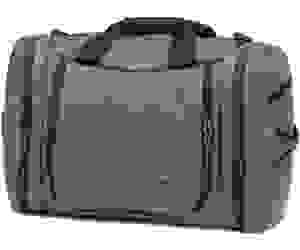
Tom Bihn is known for exceptional attention to detail, tiny little organizational perks, and super tough materials. They tend to win over fans for life, and that’s how long their bags seem to last, too. Many of them end up collecting the whole set.
They also provide far more compartmentalization than most other options; instead of one big compartment and a few extra pockets on the outside that are really just flat slots, they tend to have multiple three-dimensional areas, for splitting up large items, and not just little ones.
Pictured is the Aeronaut, a convertible duffel bag with disappearing backpack straps that zip away when you don’t want to use them, along with an optional waist strap, and an optional shoulder strap for shoulder bag mode. The main compartment opens up with a U-shaped panel, allowing for far more convenient loading and unloading than a typical straight-zipper duffel would allow, and the spacious side compartments on either end allow for plenty of organizational access, even for large items, without having to open the main section. The 45 liter version is a full-size pack, but it comes in a 30 liter version as well, for those strict European carriers.
Though it has plenty of compartments, it doesn’t have anywhere specifically intended for a laptop or a water bottle, though you could easily find homes for these somewhere in the setup. Also, keep in mind that the optional hip belt is just a strap, so it’s better for shorter walks. I tend to think of this design primarily as a duffel bag, with the option of backpack straps if necessary, but with the minimal hip belt and non-meshy back panel (which is just the regular exterior fabric of the rest of the bag), I’d try to avoid all-day use while in backpack mode with this one.
Get it here.
Update: I got a chance to test the smaller version of this bag (30 liters), but the features are identical, so if you want to see a ridiculously detailed review, take a look here.
9) Patagonia MLC
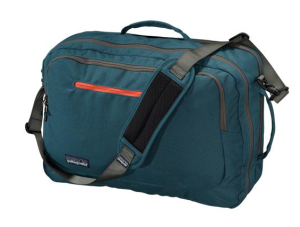
The MLC stands for “Maximum Legal Carry-on,” and thus it’ll give you plenty of room. It opens up all the way like a suitcase, but splits the cargo in two, storing some of it in the “door.” This keeps things more organized than a standard compartment, especially for dividing clean laundry from used clothing. Exterior compartments round out the organization as well.
It has carrying handles, a shoulder strap, and backpack straps, a laptop compartment, and Patagonia’s ironclad guarantee. It’s a solidly built carry-on that’ll last you for years. I will say that because it’s primarily designed as a shoulder bag, without a mesh back panel and no hip belt, that it’s better to think of this as a shoulder bag than a backpack. You might be fine carrying it through an airport for a little while, but you probably wouldn’t want to go on any long walks or hikes with it. It does have a sternum strap, so that helps, but I wouldn’t think of it as a dedicated backpack.
This model is known as the “Headway,” although they have another version known as the “Black Hole” MLC, with a super weather-resistant fabric.
Pick it up here.
Option 4: From the outdoor world
These last few options are from outdoorsy companies, whose travel-specific options are also pretty solid.
10) REI Ruckpack 40
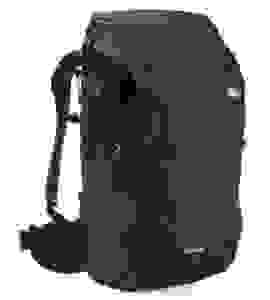
REI has had a place on this list for quite some time, although they’ve changed things up with new models every so often; the current incarnation of their travel pack is the Ruckpack 40, available in both men’s and women’s versions.
The Ruckpack is geared a bit more toward the outdoorsy crowd than digital nomads, with super-tough straps and a giant hip belt, but no laptop compartment. There’s a hydration bladder sleeve that could double as a laptop sleeve, but you’ll need to bring your own cushioned sleeve if you want protection. That’ll work, but it’s definitely more outdoorsy than tech-oriented, especially since it throws in a rain cover.
Still, it’s (nearly) a full-size pack, with a serious suspension system, which is easily its best feature, especially compared to some of the other minimal packs that are more for airline transportation than long hikes. It also has easy access from both the top and the fully-opening front panel (integrated together with a single zipper), and plenty of exterior organization, including small pockets for lots of small items. Those outer pockets do have a compression strap over them, which is a little odd, since it limits accessibility, but it’s a minor safety feature as well, since it’s just a bit more fiddly to deal with than just a zipper.
It’s just a bit too tall to be a carry-on, but the good news is that the top pocket squishes flat, so that’ll bring you into compliance with strict airline requirements, as opposed to some of the other, more rigid designs that don’t allow this. And if you do check the bag, the straps tuck away.
Get it here.
That’s the men’s version, but don’t forget there’s a women’s version there, too (and for a much lighter but otherwise similar pack, check out their Trail 40).
11) Osprey Farpoint 40
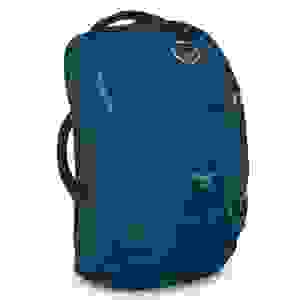
So I’ve decided to add this to the list, as it’s a popular pack with a great reputation, and it’s definitely worth checking out. It’s just that it does a few things that annoy the hell out of me, as is the case with all Osprey packs, but I’ll get to that in a minute.
First, the good: It’s a carry-on sized backpack with a full-length panel loading design, a dedicated laptop compartment, and hide-away shoulder straps. And those are good shoulder straps, and the waist belt is great, too. They really didn’t skimp on this feature, and it’s also available in two different torso length sizes, so it’s definitely going to be comfortable. And by the way, it’s probably going to be significantly more comfortable than the Osprey Porter 46, which is incredibly similar, but comes in just one size, and with daintier straps. I like how it has an organizer panel on the front, and its compression straps flatten things down by closing its semi-rigid sidewalls, which is a clever way to handle things.
And now, the bad: Osprey never ceases to amaze me with their insistence on using non-stretchy mesh water bottle pockets, with compression straps that go right over the pockets to make them a million times harder to use. I really don’t get it. I also find it to be something of a nuisance how the compression straps block access to the main zippered compartment, meaning it’ll be kind of a hassle getting into and out of the bag. The Farpoint has small external pockets, but the big ones are stuck behind the straps, in a way that annoys me a little more than some of the other packs listed here.
Still, it’ll definitely work, and its hiking pack pedigree means it’ll be a comfortable pack to carry. Another odd, but workable feature is how it carries the laptop on the side farthest from your back. I initially didn’t appreciate this feature, but as laptops become smaller and lighter, the weight distribution is less of an issue, and it protects it from getting squished between your back and the rest of the load.
Get it here.
(You’ll notice the larger versions have a detachable day pack, but not the 40 liter version)
So what makes a good travel pack?
You’ll notice that these packs generally have a number of features in common, some of which I mentioned as necessities, and some of which are easier to see once you line them all up in a row. These are the features of a good carry on backpack ideally suited for travel:
- Carry-on size: 45 liters is plenty for lifelong, indefinite travel all over the world. I did it in 20. You can do it in 45. And if you still want the “extra” pack for quick day trips, consider a compressible one. By the way, keep in mind that certain regional European carriers have stricter limits; 35 liters will likely be fine for them.
- Hide-away straps: But if you do want to check a bag, you certainly can. The straps tuck away so they can’t get snagged or damaged, which is also useful for stuffing them into overhead bins or under a seat.
- Multiple carrying options: You’ll notice each of these packs has at least two handles, always in the same place; the top, and the side. This allows you to carry it like a briefcase, or pull it out of an overhead bin. Plus, the aforementioned backpack straps and occasional messenger bag straps let you carry them however you feel like it.
- Internal compression straps: You pack the bag while it’s flat, then turn it upright. The compression straps keep everything stuck the way you packed it.
- Minimal external compression straps: No dangly silliness to get stuck on whatever. They’re useful, sure, but dammit, why don’t the hiking companies have the dangly end hang on to something so it doesn’t dangle?
- Laptop compartment: Our lives exist in the digital ether. I’ll tell people to skip the laptop if they’re not going to use it, but digital nomads need it, and most people will want one anyway.
- Locking zippers: It’s just that easy to keep your bag protected. Other bags have steel mesh reinforcements throughout the bag, but…the cost/benefit ratio isn’t so ideal. Locking zippers are easy, and hugely helpful (though I’ve recently seen techniques to bypass the lock, so I’ve softened on this as a requirement).
- Flat packing: The whole thing lies down so you can pack it like a suitcase. This is incredibly useful. I don’t know why it’s so rare in the hiking world.
Potential areas for improvement
I do, however, have some problems with certain aspects of carry on backpack designs. Now remember, I’m a nitpicky bastard that can never be satisfied, but dammit, it’s because I’m right. But keep in mind these are issues worth thinking about, rather than deal-breaking problems.
- Minimal hip straps: Transferring the load to your hips makes a huge difference. It’s the difference between “I need a massage” and “let’s go party.” For large, muscular specimens of masculinity, this is probably not such a big deal. It’s also easy to manage if you go straight from the bus station to the hostel, but I’ve often found myself wandering around town with my pack, and it’ll probably happen to you sooner or later as well. It would be nice to see detachable hip straps as an add-on option, though as mentioned, a few of the above options (Tortuga and REI Vagabond) have more serious hip straps than the others, and a simple strap can go a long way in improving the comfort of smaller gear setups.
- Minimal ventilation: This is another problem that arises from longer walks. If it’s winter or you don’t sweat much or you’re going straight to the hostel, good for you. If you plan on walking around for an hour, it’s going to be an issue. I’d normally say the trampoline-style back panel is great, but it’s tough to recommend it for the problems these packs are trying to solve. These packs are supposed to go through luggage checks with no problems, and the trampoline back would need to be protected in order to accommodate that. However, a raised lumbar pad and raised shoulder blade pads would go a long way in diminishing the ventilation problem, without sticking out too much.
- “Water bottle pockets” that don’t fit a water bottle: I’ll start by pointing out that most of the options above are fine in regards to this problem, but I will never stop complaining about inadequate water bottle pockets, because goddammit where the hell do they go?!?!
But again, these are just potential problems. The hip strap issue is likely the most objectively serious, and it’s definitely something to think about if you expect to be walking far and wide on your worldly adventures.
But, all in all, I like these designs. I also like the existence of these designs. I expect carry-on, hybrid packs like these to become increasingly popular, because they’re so efficiently designed to accommodate the needs of lightweight travelers who still need backpack straps, and once you get one…you’ll never need anything else.

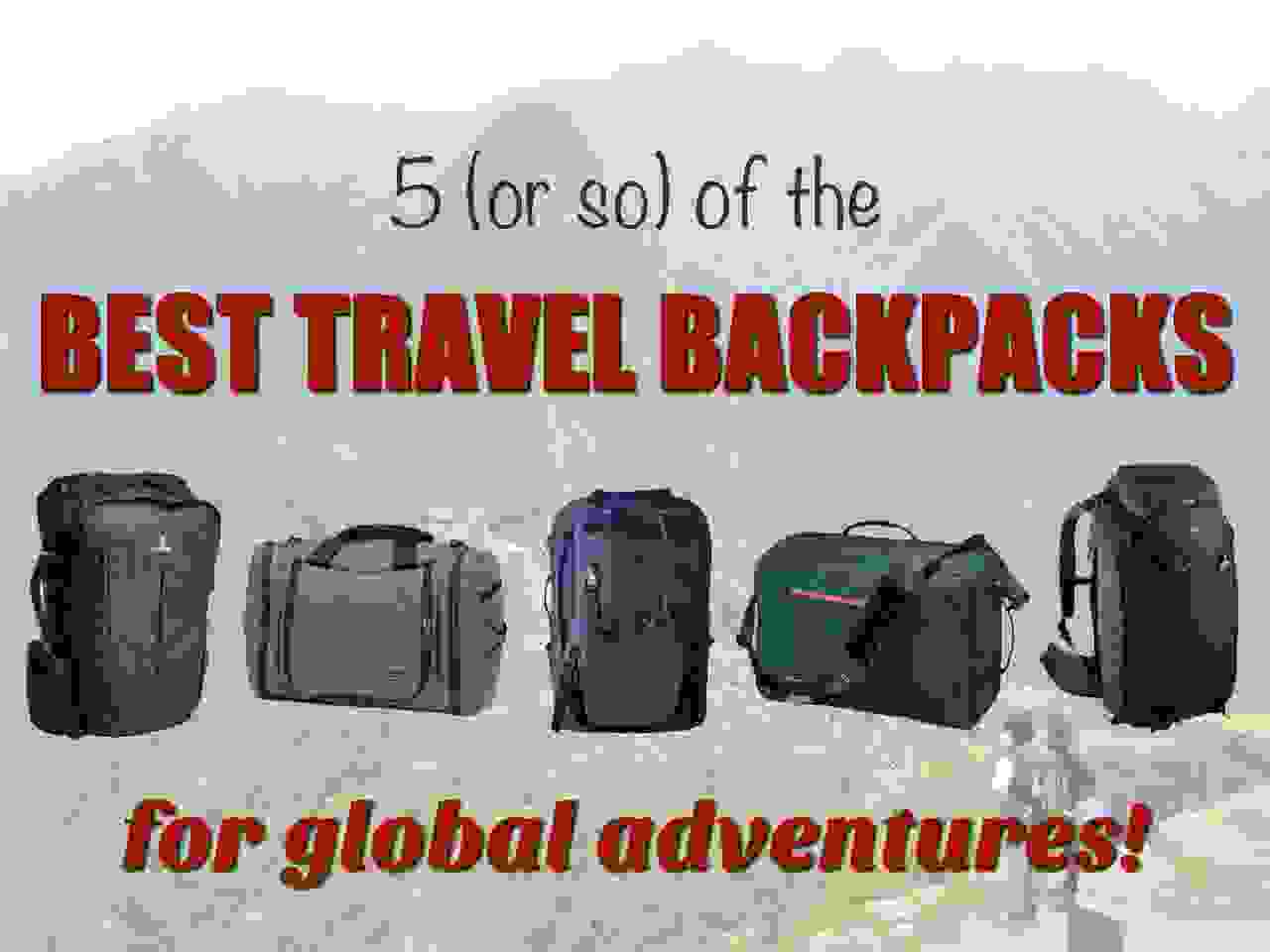
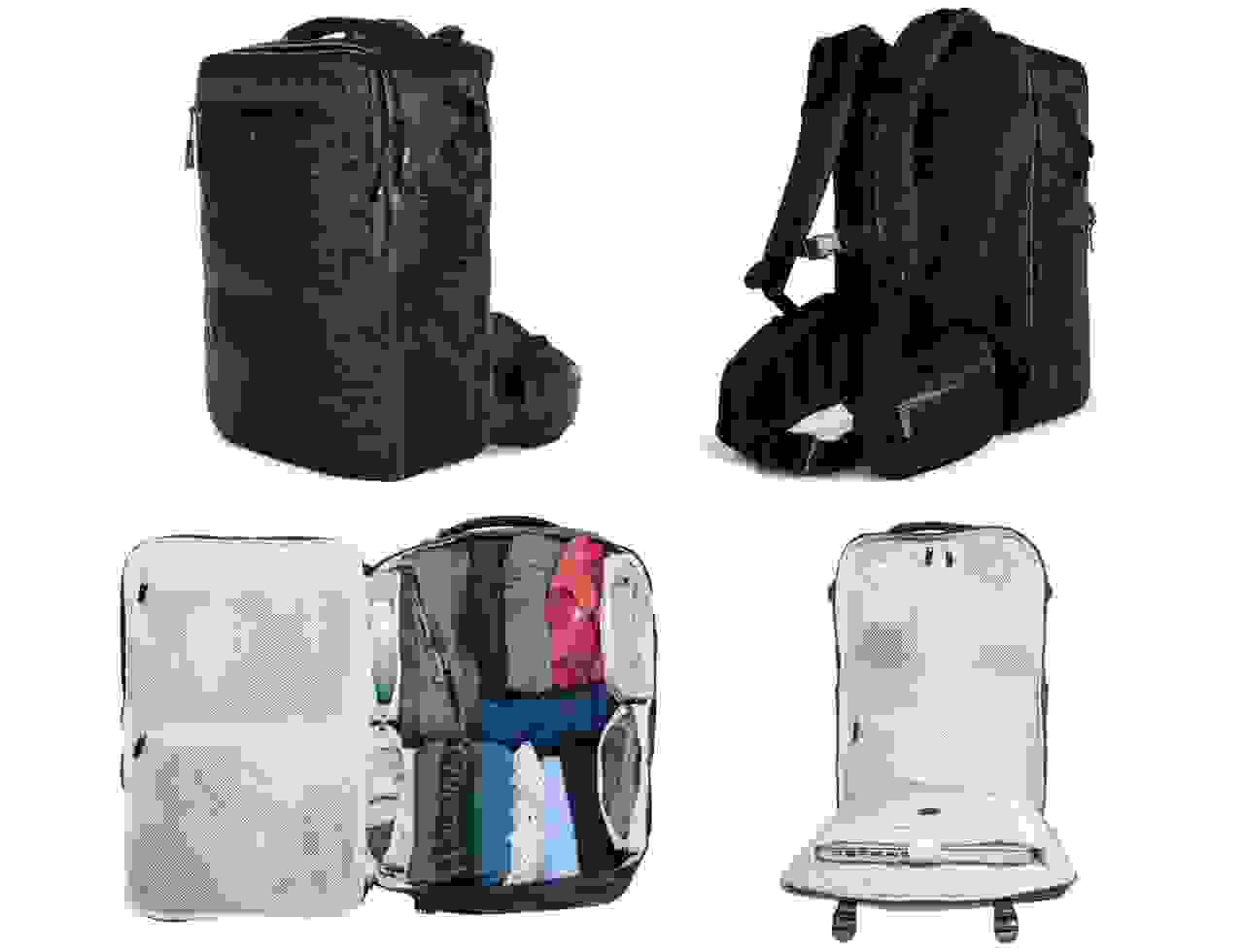
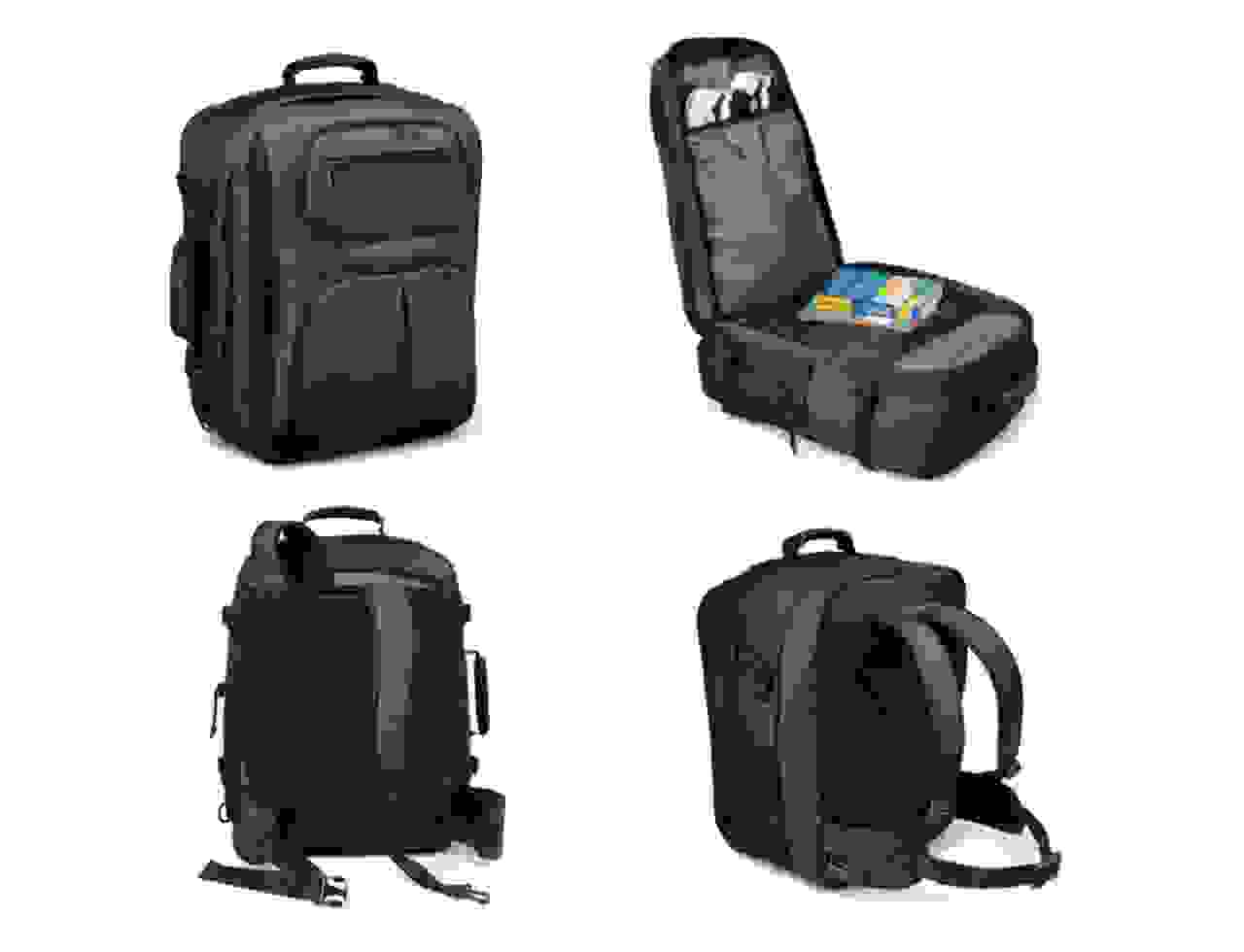
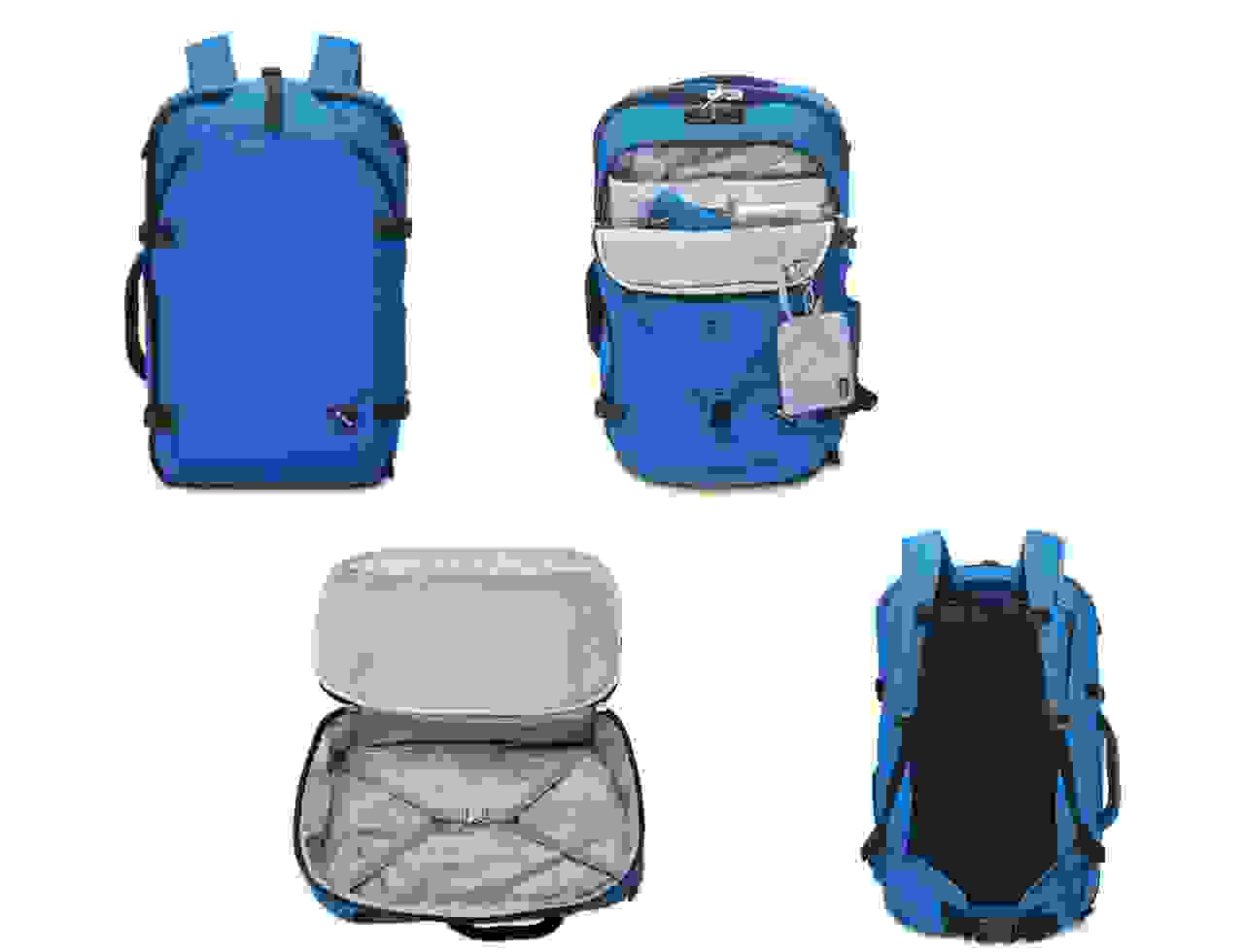
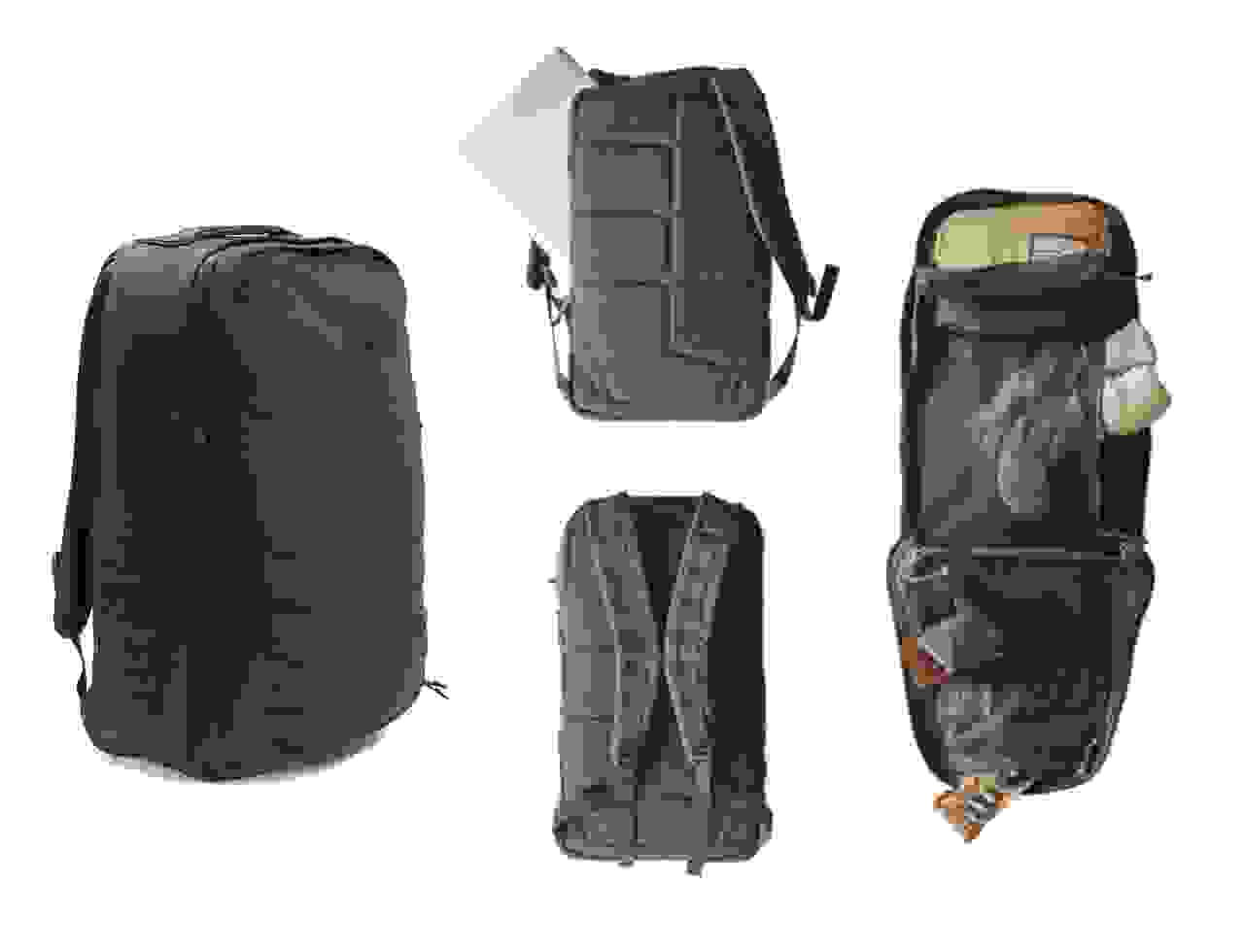
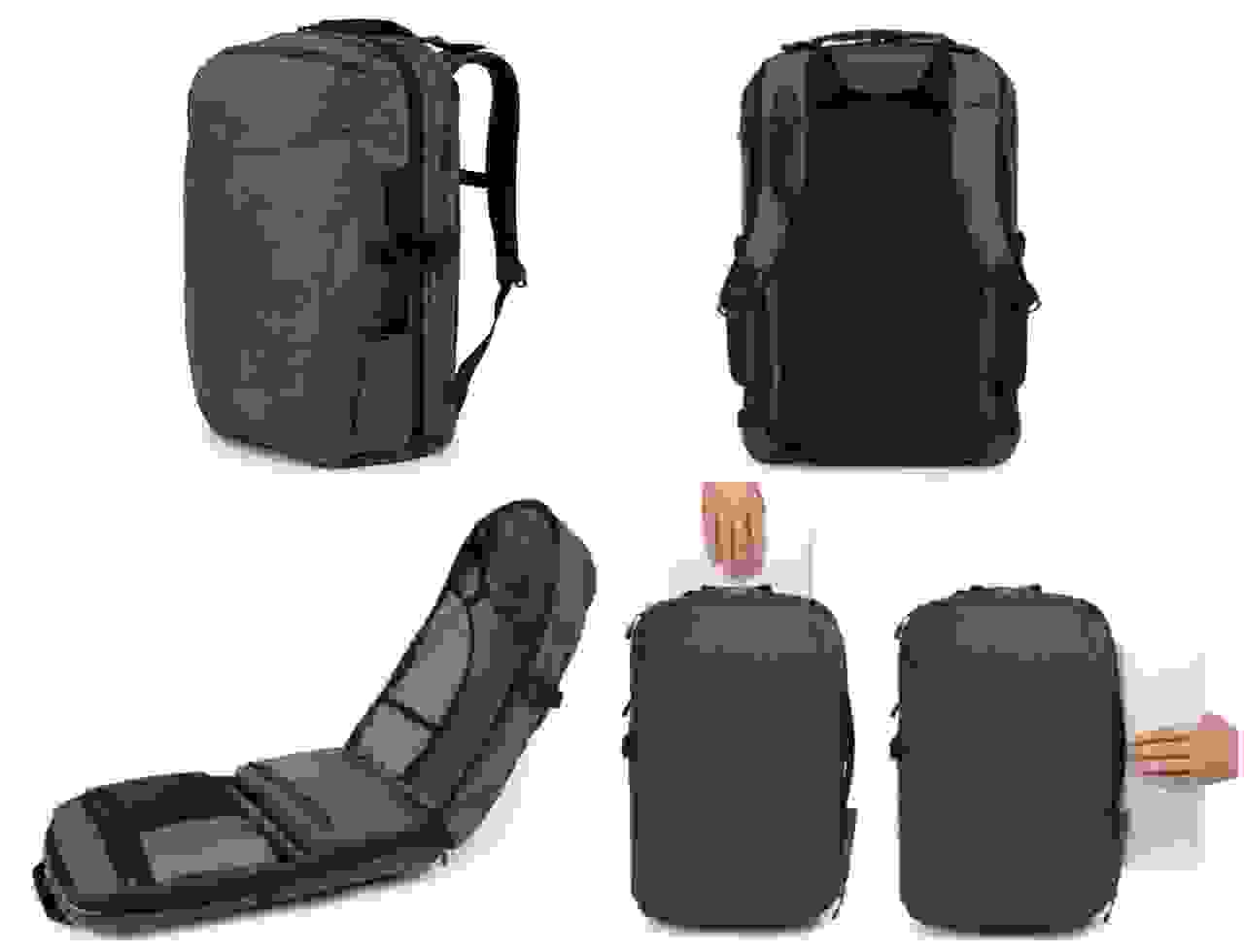
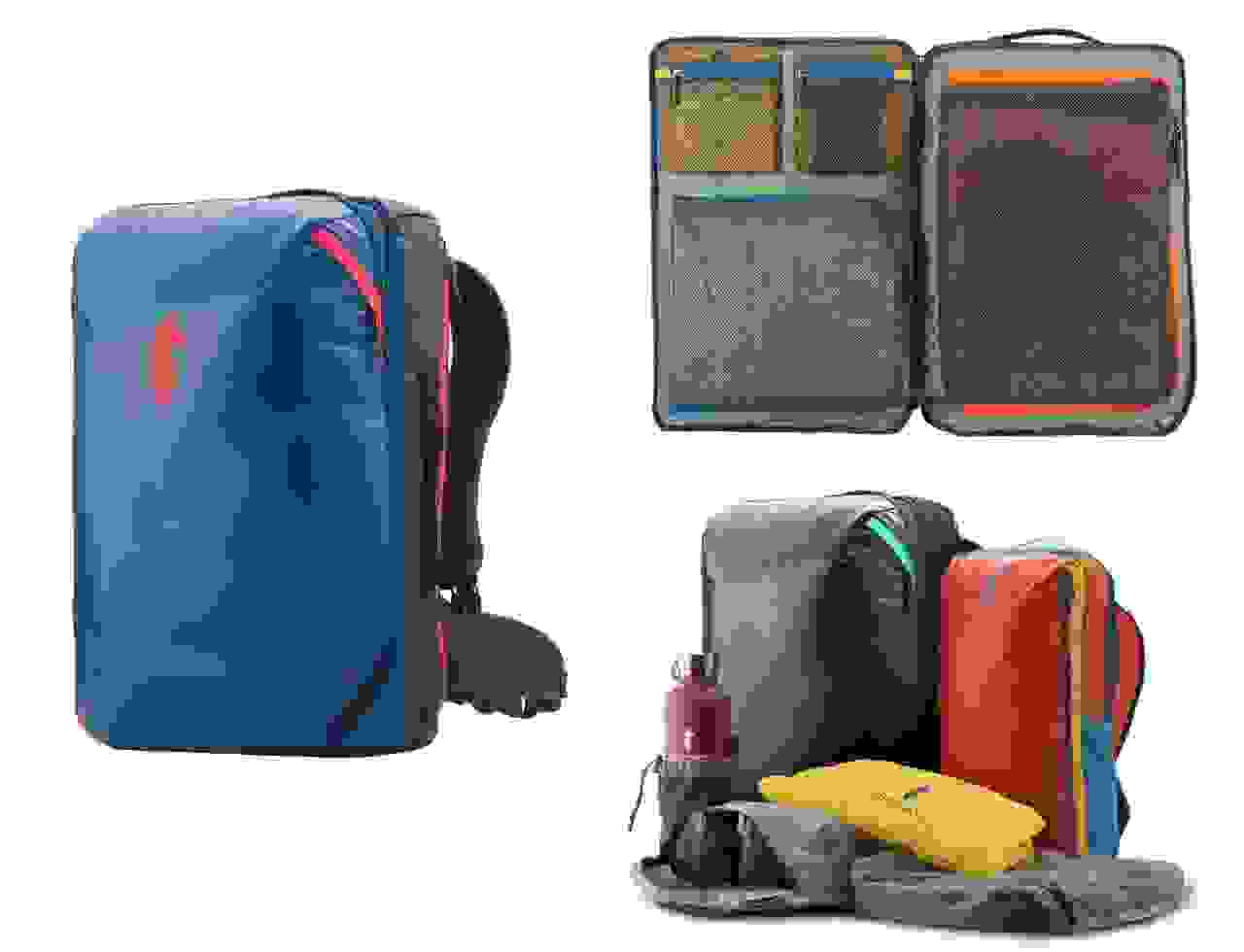
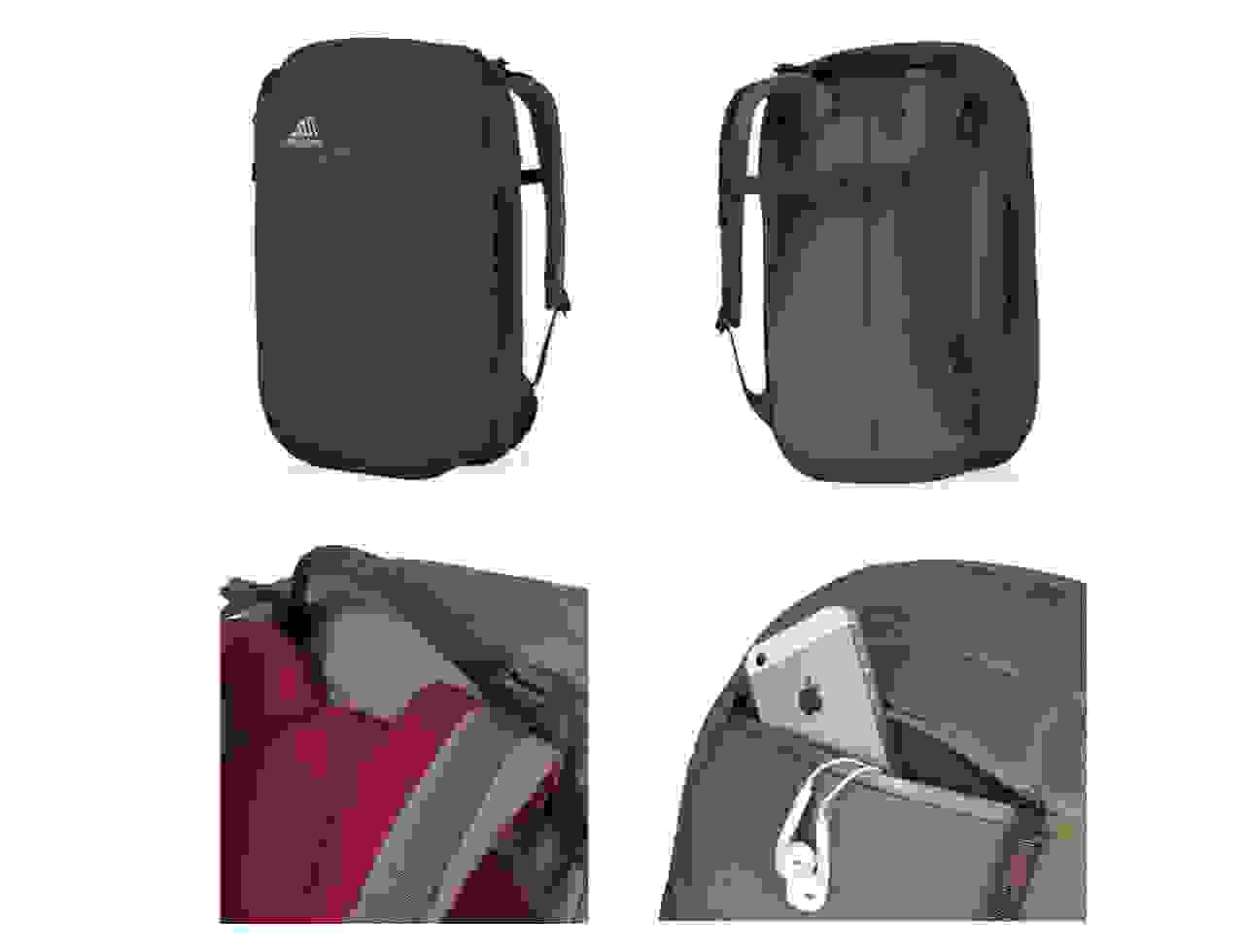
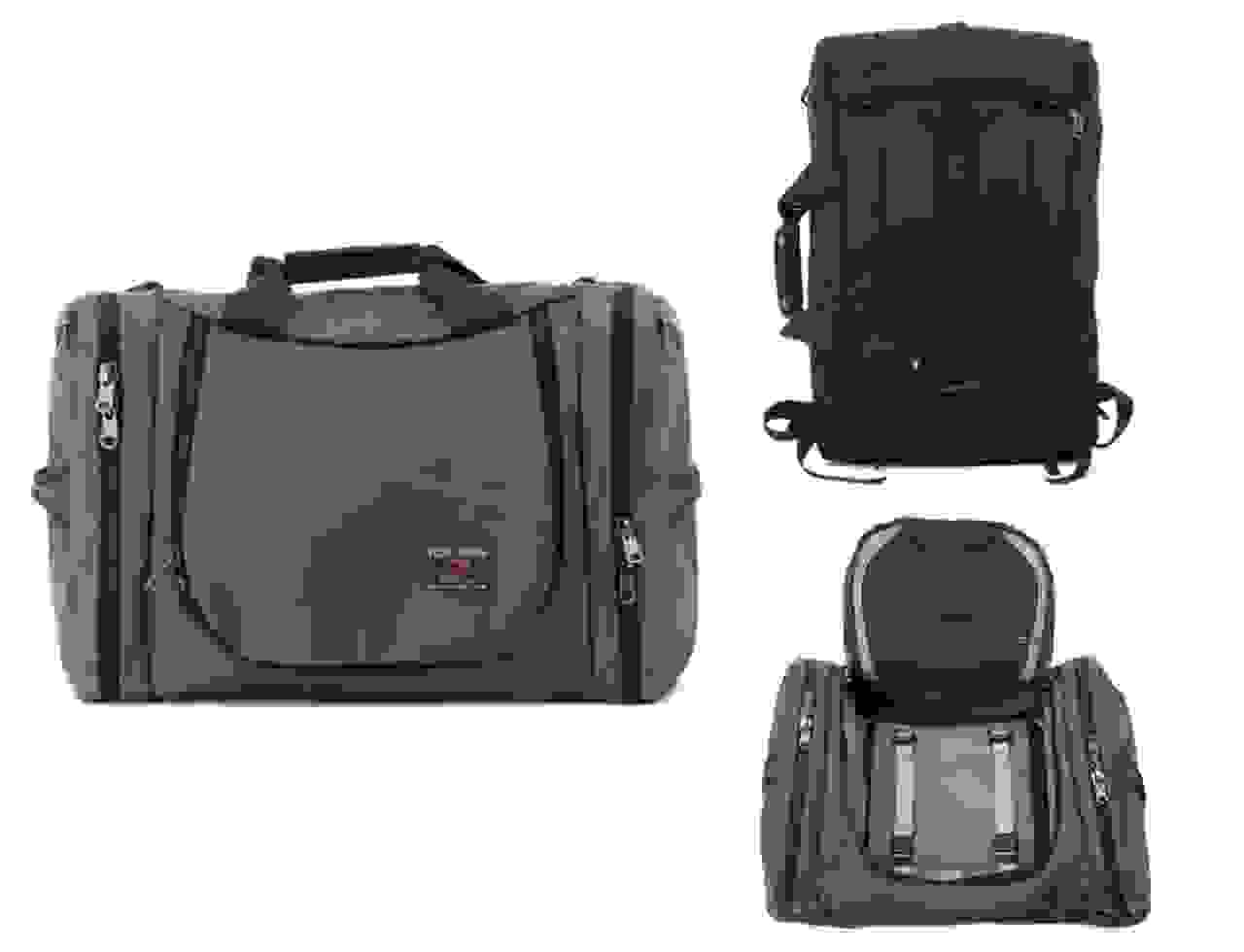
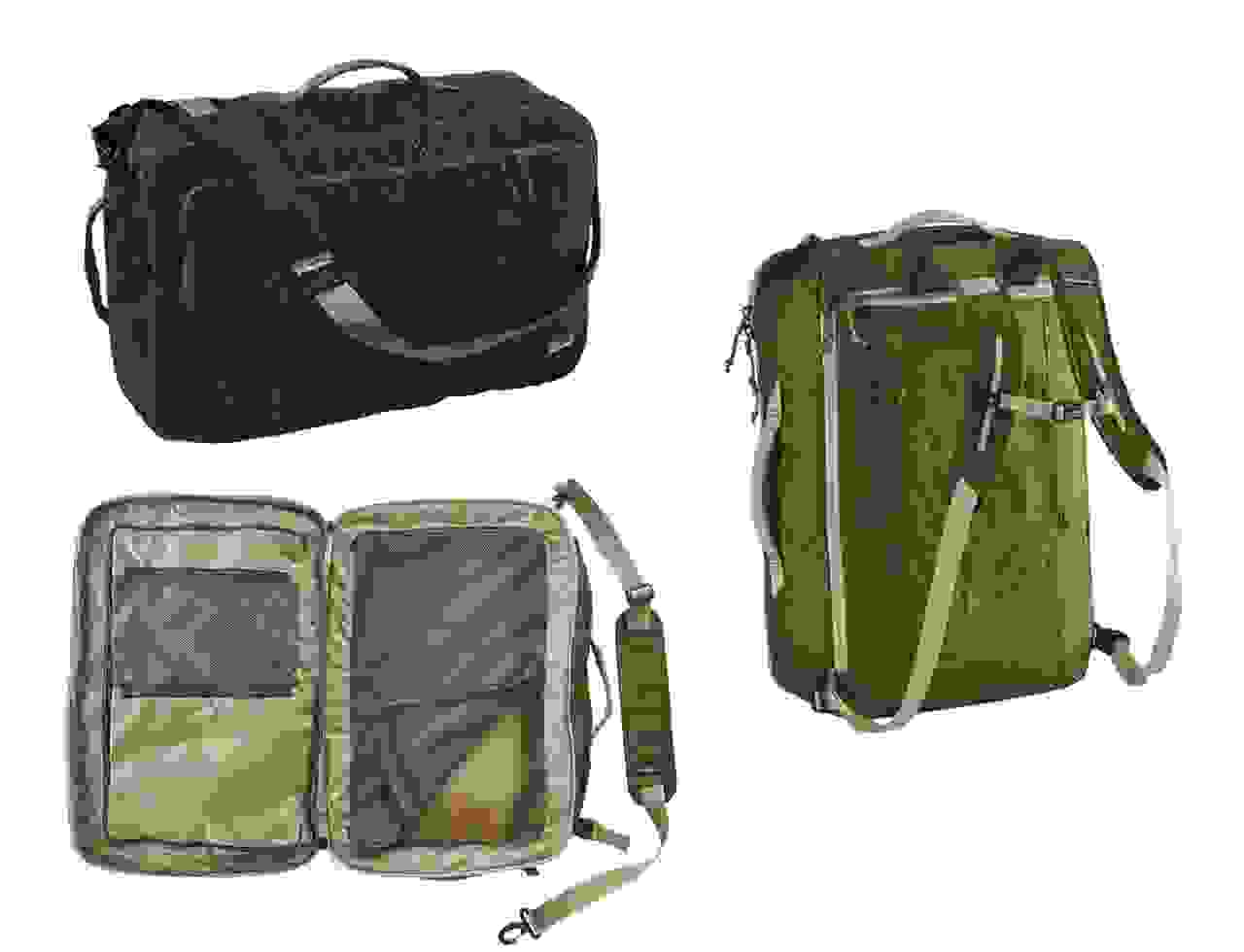
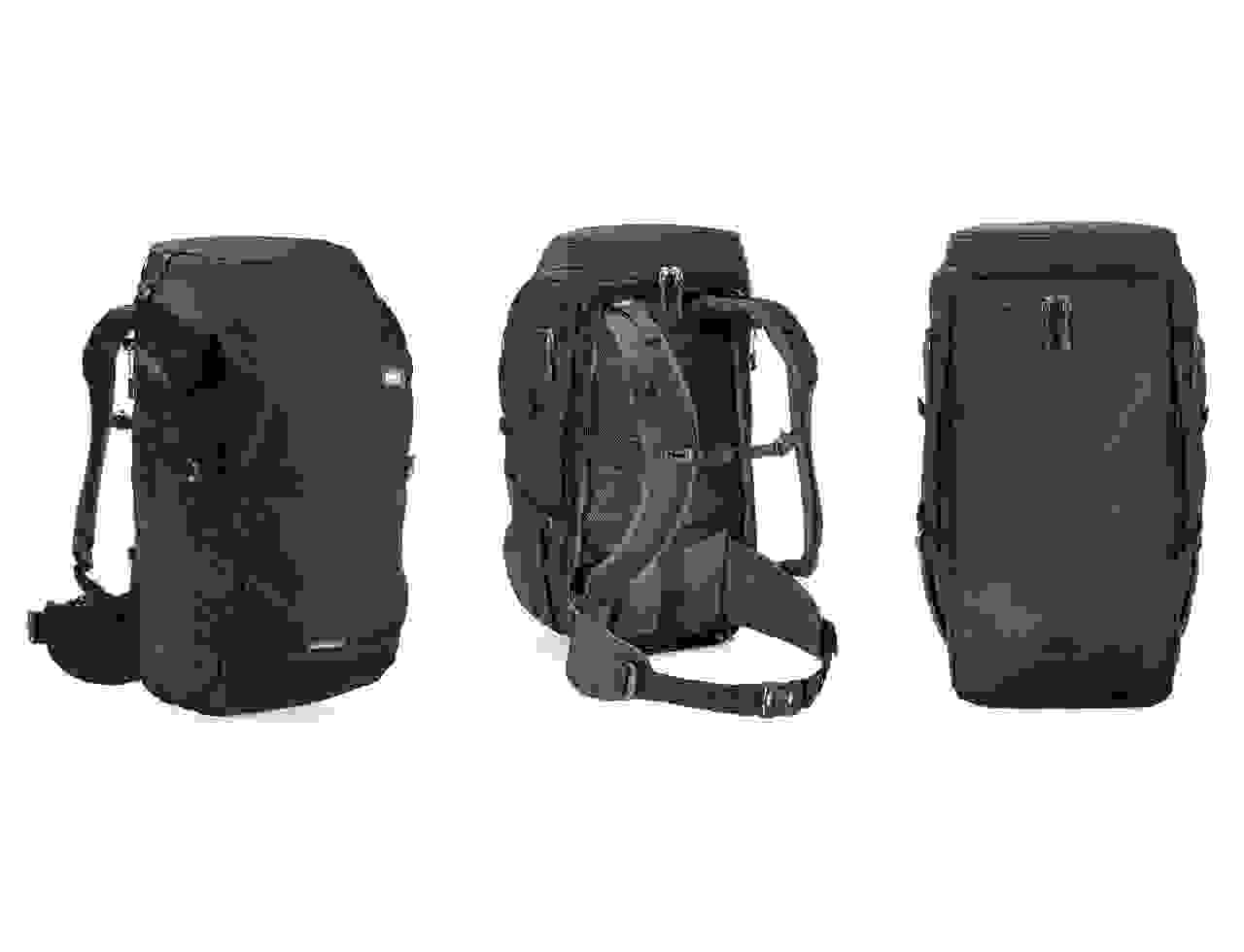
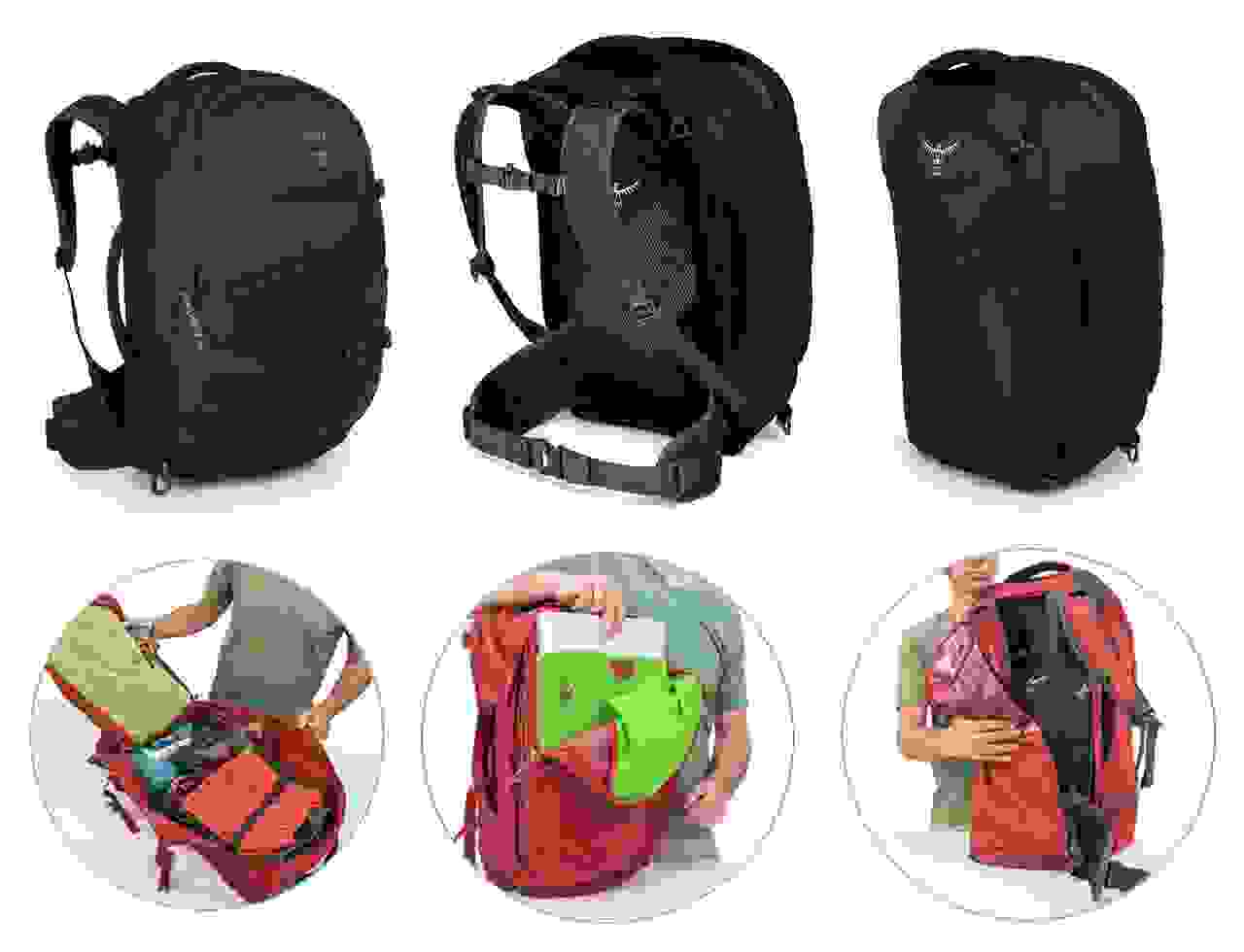



Hey Eytan, Thanks for including Tortuga in this post. We’re in great company. Sounds like we have a similar travel style since our original checklist looks a lot like yours.
Do you also carry a smaller pack with you? If so, I’d love to see a similar breakdown of what you’re looking for in a daypack.
Thanks,
Fred
Yup, I have a small daypack that stuffs into its own pocket. Right now I’m using the ChicoBag Daypack 15, which I like a lot. I made a list of my favorites here. I picked the ChicoBag because it had water bottle pockets, looks pretty normal, and is lighter than some of its competitors, despite having several pockets. I like it a lot, though I avoid dragging it along gravel. Obviously.
Thanks, Eytan. I broke down some other bags that I’ve seen travelers using here: http://www.tortugabackpacks.com/pages/competitors. Even Timbuk2 and InCase, traditionally commuter bag companies, are now making “travel” backpacks. Yes, everyone is jumping on the bandwagon.
I’ve seen some from Eagle Creek as well, though the particular ones I saw weren’t all that exciting. But I like seeing more companies doing this, since that’s all backpackers need.
I like that side-by-side comparison page, and I agree that the Tortuga is the most full-featured of the packs listed here. The hip belt in particular is a very big deal to small people.
Fred, the Torgtuga is absolutely amazing! One of my good friend’s owns one, and I was fortunate enough to use it. In fact, I even tried to buy one today, for I will be traveling to Europe this May. Unfortunately, it appears that they will be out of stock until may. I have spent several hours now scouring the darkest corners of the internet in the hopes that I could find one for sale, but my search has been to no avail; however, during the search I did manage to find some things on the internet that I wish I had not seen. I’ve searched your website, amazon, craigslist, backcountry, and many other sites. Are there any other places of which you can think from where I might be able to acquire one?
Also, Eytan, I am 20 years old, and I come from a family of travelers. My father is adamant in his belief that backpack technology has not changed appreciably since he traveled the world with my mother in the early 1980s. After reading many of your articles I feel sufficiently well-informed on a myriad of travel topics – that is to say “well-enough” informed to at least be able to stand my ground in a discussion regarding travel equipment with my father, and for that I thank you. This upcoming summer will be the first time I travel to another continent completely by myself, and many of your articles have been extremely helpful and informative, and they have definitely taken some of the stress out of the trip planning process.
Hmmm, backpacks haven’t changed since the 80s? I’m not sure what he means by that, but I’d bet him his pack is twice as heavy as typical options today. I suppose he might mean the designs are conceptually similar, in that they are a backpack with hip straps and whatever…but I don’t think it was possibly to bring your gear down to the minimal weight that can be accomplished today.
And I certainly appreciate providing any sort of help. I tend to accumulate dorky amounts of knowledge on these sorts of things, and I’m glad they’re not just sitting in my brain.
As for the Tortuga, they’re about to release the Tortuga Air; if that doesn’t work, take your friend’s Tortuga and buy him a new one in May; if that doesn’t work, just buy anything from a big name brand and sell it on eBay when you get back. Not a great solution, but if you have your heart set on something, you’ve got to go for the one you love.
Hi Eytan, you have a great site here. I’ve lived/worked in many countries over many years (I’m 64 young), and have travelled to a couple of other places too, but you really do give me what I need to take the next step on my life journey (I’m an artist so can do my thing anywhere).
Just ordered a Tri Star (Tom Bihn) and waiting till im next in the UK to buy some ‘jeans-plus’ (Rohan), both from your site. Thanks mate. Travel Safe. Bev
As I have mentioned to others, I can’t wait to meet someone in some random hostel in the middle of some far-off wilderness, dressed exactly the same as me, and carrying the same gear. It’s gonna be great.
Hi….. on a four month trip to south east Asia last year…. I used a max size carry-onbag that I ordered from MEI in California. by Genuine Gear, Inc.
https://www.google.ca/#q=mei+voyageur
http://www.meipacks.com/TravelPacks01.html
Called the Voyageur… they’ve been making it since the 1970’s… and I’ve always figured that a something continuing to be made for so many years must be of fairly high quality. I’m very happy with it…. and since it is 14x9x22″; 3.5 LBS…
It forces me to not over-pack…but to instead..pack light.
Here is a website I like about packing light…. with one carry-on size bag. Even if you are going for many months…or even years…
http://www.onebag.com
My bag has a great harness system with waist belt and shoulder straps that zip up behind a panel when you use a shoulder strap or the carry handle.
No wheel system… so it weighs much less than most bags the same size that have wheels… and no room in the bag is taken up by a system for pulling wheels bags along behind you. As long as I am still healthy and sting…. I prefer a back pack that I can also carry with a shoulder strap or by the carry handle if I wish.
Some day… when I am older and not able to get around so easy…. I may break down and by a wheelie bag……
My little day pack is made by Eagle Creek. Their Packable Day Pack, which packs say into it’s own pocket and can fit into the cargo pocket of travel pants…
Those are my personal choices, and I’m very happy with them on my travels
But there are many other good bags out there that other people are also very happy with and do just as good a job as my bags…
All of us have our own personal preferences in our travel bags.. and they are all worthy of consideration.
Just a matter of researching them all online or at your closest outdoors stores…
Good luck and safe travels…
Yup, I’m familiar with those, and plenty of people are happy with them. Personally I’d prefer a few more external pockets for easy access to frequently-used items, but some people don’t mind. And I just like the fact that more and more people are doing this, as it wasn’t so frequent, even just a decade ago.
A vote for Tortuga: first-rate customer service, advice offered, etc. They’re the sort of people I’d go out for a beer with if they were based in NYC or Toronto (my two cities).
Just bought my Tortuga pack…received it in the mail a few days ago, and have been packing it as a trial. It was WAY over-filled at first, because I was waiting on certain gear to arrive in the mail. As each item comes in, I replace its bulky counterpart in the pack and REVEL in my newfound reduced weight/bulge. A peculiar pleasure!
Making a particular difference:
towel —> Outlier linen towel (huge change)
boxers –> Uniqlo Airism x 6 (huge diff)
rain poncho –> Uniqlo down jacket (packs into pocket, amazingly small/light)
Still waiting on my Rohan Jeans Plus!
Since when are travel packs a new thing? I bought my first Eagle Creek one 1995 and used it up until about 5 years ago. It is still a great pack and beats the second Eagle Creek one I bought to replace it because I thought it was better.
I am currently using the Tortuga V1 which I won in a twitter contest. I really like the dual compartments of the bag and the fact that it is square on all sides. It will also stand up on its own which is nice when you are waiting in airports or train station and don’t want to have to prop it up. The bag will hold a lot more than bags of the same size. I have considered trading up to V2 but I really like the dual compartments.
I was perhaps exaggerating if I implied they were “new.” But they seem few and far between even today. If you look at Eagle Creek’s selection and delete all the rolling suitcases and 70 liter or bigger backpacks, the remainder is extremely small. Not nonexistent, but suitcases and massive packs ruled the day.
I think if you’re happy with a pack, then it’s nice to stick with it. I think the full-size opening of the new version is a better design for most people (they had a flute-playing customer who wanted to be able to fit a whole flute into the pack, for example), but if you like the dual compartments and you’re happy with it, that’s great too. And the not-falling-over thing…yes, that is exquisite.
Thank you for sharing this guide. I think laptop compartment will always be a priority when choosing a backpack.
You make such a good point about outdoor backpacks swallowing your gear. The first time I traveled overseas I had this bag that only opened from the top. If I wanted something from the bottom, I had to take EVERYTHING out. Seemed like I always wanted something from the bottom. That bag has long been retired for overseas trips, but I am still looking for a better solution. I like the REI Vagabond. I usually put my laptop in a smaller backpack anyway.
I’d recommend the Gregory Z40 too. It has panel and top loading and has a trampoline-style ventilating back panel, and I was a big fan of the older version. Oh, and packing cubes for the top loaders. I think it’s a little annoying to spend extra money on packing cubes when a panel loader would eliminate the need for them, but if comfort is critical, you can get around the organizational awkwardness fairly easily with the cubes.
Hey Eytan,
Nice post (& website… I just got sucked into a half-hour vortex of post-reading before breakfast).
Great to find another traveller so passionate about carry-on travel. Found myself vigorously nodding along to the post.
Couple of comments that might interest you or your readers:
1) “No hip strap” is not strictly true. We provide a 35mm high-quality webbing stabiliser strap that is completely removable so that when you don’t need it, it’s not hanging around making you look unprofessional. While that’s almost certainly not what you in particular are looking for in terms of padding etc, I can report it does take some weight off the shoulders and is seriously useful in stabilising the bag in certain situations (eg on the back of a motorbike).
2) One of the most surprising things in creating this bag was discovering how arbitrary industry volume ratings are. While on paper we’re smaller than some other bags on the market, we suspect some are overstating their volume and/or don’t necessarily pack as much as we can, due to interior clutter. If you haven’t seen it already, here’s a packing video one of our product testers made showing how much you can fit in: https://www.youtube.com/watch?v=m3J3nnRrsa8
If you (or anyone else) have any questions I’m happy to answer.
Cheers!
Thanks for the correction. I’ve updated the hip strap info. And in regards to volume, I’ve also noticed plenty of bags that feel larger or smaller than their claimed size. I remember reading years ago of a company attempting to standardize volume measurements through a method that involved filling up the bag with marbles and counting how many you could fit inside. Seemed like a decent strategy, if they could get everyone in on it. And I think 35 is just fine anyway, especially if it packs flat.
And I’d wish you guys the best of luck since you’ve only just started, but I’ve seen your Kickstarter numbers and they look great already. Glad to see something like this make its way into the world.
Cheers for the update.
That’s basically the method we use for capacity measurement, but good luck getting bag companies to agree on a standard!
The REI Vagabond 40 looks great. I’ve looked at a few of these types of packs & my main concern is how they will feel when hiking in Torres del Paine, the Inca trail etc. My aim is to go as light as possible – this bag looks like a good compromise.
Oh, now I read that the vagabond is a bit too close to the carry on restriction limit. Scratch that. I’ve just found Tom Bihn’s Synapse 25
http://www.tombihn.com/backpacks/TB0111.html
This looks like the real deal!
That one’s a good one, though I consider it more of an ideal everyday pack, rather than specifically ideal for travel, since it’s missing the full-length opening, locking zippers, etc. But if you’re going super ultralight, it can work, and it’s also a really nice pack.
I’m leaning more towards the Tom Bihn Smart Alec now, though I am concerned about the flat mesh back. I can see it getting seriously hot without raised ventilation:
http://www.tombihn.com/PROD/TB0103.html
Eytan, great article and keep up the good work. You’re 100% spot on that this is an emerging category. Airline baggage fees are creating a demand for carry-on options and as someone who has to regularly “hike” O’Hare International, I can confirm that travel backpacks are a great way to go when you’re on the move. I currently use a Tom Bihn Tri-Star, which is the slightly smaller brother of the Aeronaut.
BTW, one other popular bag that probably deserves to be on this list is the Red Oxx Sky Train. Red Oxx is a brand that is very popular among one bag travelers and the Sky Train has been out there for a while.
Yeah, I’ve seen both of those and they both look like they’d work for this type of thing. I’m glad to see more companies doing it, because it used to be that when I told people I traveled only with a carry on, they’d look at me like I just burned their house down.
Hey! great post. I’m looking for a bag for my next trip in SEA (1 year), I was very tempted by the Tortuga bag but the shipping cost for me, since I live in Canada, is way too high. So I saw this bag “ebags Mother Lode TLS Weekender Convertible” at a cheap price 99$, have you ever tried it? thanks.
I haven’t tried it in person, but it looks like it has plenty of the qualities I’d want, except maybe a water bottle pocket. The straps look a little on the thin side, so smaller people might want to avoid long walks, but I think it’ll work. It has lots of great reviews too.
I was looking through the comments to see if anyone would bring up the Mother Lode, it’s great reviews have made me very intrigued and I want to try it out. Just a little note, it actually does have a water bottle sleeve – there is a small zipper pocket on the side that has a little sleeve you can pull out and put a water bottle in. There is a video on amazon (and I would assume their website also) that shows all the features.
My only concern, as a small little lady, is the straps. I’ll definitely be looking into some of these other bags, thanks for this post!
Ah, I see it now. Interesting pop-out design. It looks like the idea was to make a bag that would suit everyone, so they have all sorts of removable features, yet it’s still pretty cheap. It looks like quite a well-organzied bag, and people seem to like it. But padded hip straps would be quite helpful for smaller people, especially if you plan on walking around a lot.
Great choice of backpacks. I would like to add another brand here that I use as a family. 4 of these bags is ample to go on a good holiday with 2 adults and 2 kids.
The first is the Tatonka flightcase – http://www.tatonka.com/Products/Backpacks-and-Bags/bags/Flightcase/1151
This bag has a separate laptop compartment.
The second one and a cheaper option is the Tatonka flight barrel – http://www.tatonka.com/Products/Backpacks-and-Bags/Reisetaschen/Flight-Barrel/1987404
Love your blog.
I have the original Flightcase 1150 instead of the new 1151. It works very well and what it has is the hip strap which can be removed if needed. The new 1151 doesn’t have it and is slightly smaller in dimensions. What it has is the laptop compartment.
I’ve seen the Flight Barrel and I absolutely think it is better than the new Flightcase. Tarpauline material makes it water resistant and tough. Something original Flightcase is not. It is smaller still but just love the color options.
I own a yellow Flight Barrel and it rocks. My only complaint is that it is a little heavy and a tad too big for my use now. Maybe I am getting better at packing less so 35L is too much haha!